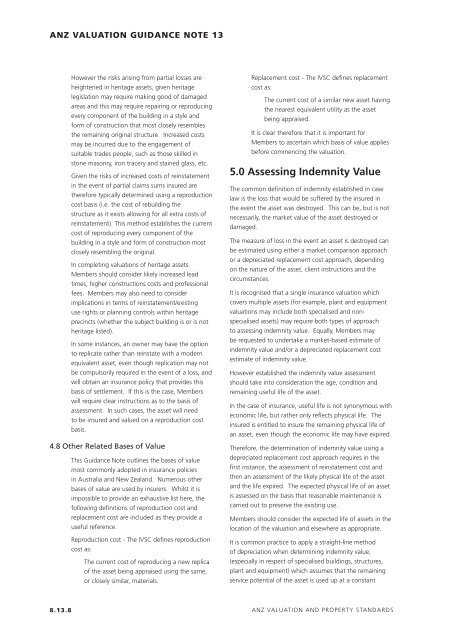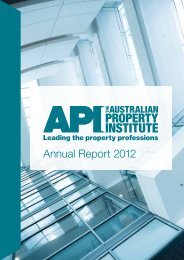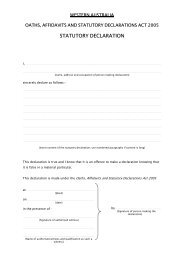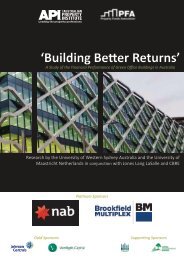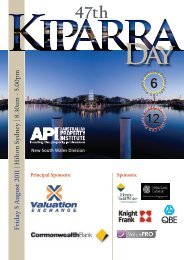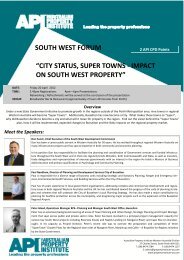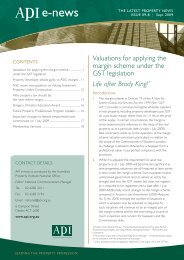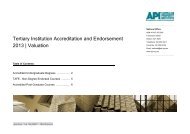VALUATIONS FOR INSURANCE PURPOSES
VALUATIONS FOR INSURANCE PURPOSES
VALUATIONS FOR INSURANCE PURPOSES
Create successful ePaper yourself
Turn your PDF publications into a flip-book with our unique Google optimized e-Paper software.
ANZ VALUATION GUIDANCE NOTE 13<br />
However the risks arising from partial losses are<br />
heightened in heritage assets, given heritage<br />
legislation may require making good of damaged<br />
areas and this may require repairing or reproducing<br />
every component of the building in a style and<br />
form of construction that most closely resembles<br />
the remaining original structure. Increased costs<br />
may be incurred due to the engagement of<br />
suitable trades people, such as those skilled in<br />
stone masonry, iron tracery and stained glass, etc.<br />
Given the risks of increased costs of reinstatement<br />
in the event of partial claims sums insured are<br />
therefore typically determined using a reproduction<br />
cost basis (i.e. the cost of rebuilding the<br />
structure as it exists allowing for all extra costs of<br />
reinstatement). This method establishes the current<br />
cost of reproducing every component of the<br />
building in a style and form of construction most<br />
closely resembling the original.<br />
In completing valuations of heritage assets<br />
Members should consider likely increased lead<br />
times, higher constructions costs and professional<br />
fees. Members may also need to consider<br />
implications in terms of reinstatement/existing<br />
use rights or planning controls within heritage<br />
precincts (whether the subject building is or is not<br />
heritage listed).<br />
In some instances, an owner may have the option<br />
to replicate rather than reinstate with a modern<br />
equivalent asset, even though replication may not<br />
be compulsorily required in the event of a loss, and<br />
will obtain an insurance policy that provides this<br />
basis of settlement. If this is the case, Members<br />
will require clear instructions as to the basis of<br />
assessment. In such cases, the asset will need<br />
to be insured and valued on a reproduction cost<br />
basis.<br />
4.8 Other Related Bases of Value<br />
This Guidance Note outlines the bases of value<br />
most commonly adopted in insurance policies<br />
in Australia and New Zealand. Numerous other<br />
bases of value are used by insurers. Whilst it is<br />
impossible to provide an exhaustive list here, the<br />
following definitions of reproduction cost and<br />
replacement cost are included as they provide a<br />
useful reference.<br />
Reproduction cost - The IVSC defines reproduction<br />
cost as:<br />
The current cost of reproducing a new replica<br />
of the asset being appraised using the same,<br />
or closely similar, materials.<br />
Replacement cost - The IVSC defines replacement<br />
cost as:<br />
The current cost of a similar new asset having<br />
the nearest equivalent utility as the asset<br />
being appraised.<br />
It is clear therefore that it is important for<br />
Members to ascertain which basis of value applies<br />
before commencing the valuation.<br />
5.0 Assessing Indemnity Value<br />
The common definition of indemnity established in case<br />
law is the loss that would be suffered by the insured in<br />
the event the asset was destroyed. This can be, but is not<br />
necessarily, the market value of the asset destroyed or<br />
damaged.<br />
The measure of loss in the event an asset is destroyed can<br />
be estimated using either a market comparison approach<br />
or a depreciated replacement cost approach, depending<br />
on the nature of the asset, client instructions and the<br />
circumstances.<br />
It is recognised that a single insurance valuation which<br />
covers multiple assets (for example, plant and equipment<br />
valuations may include both specialised and nonspecialised<br />
assets) may require both types of approach<br />
to assessing indemnity value. Equally, Members may<br />
be requested to undertake a market-based estimate of<br />
indemnity value and/or a depreciated replacement cost<br />
estimate of indemnity value.<br />
However established the indemnity value assessment<br />
should take into consideration the age, condition and<br />
remaining useful life of the asset.<br />
In the case of insurance, useful life is not synonymous with<br />
economic life, but rather only reflects physical life. The<br />
insured is entitled to insure the remaining physical life of<br />
an asset, even though the economic life may have expired.<br />
Therefore, the determination of indemnity value using a<br />
depreciated replacement cost approach requires in the<br />
first instance, the assessment of reinstatement cost and<br />
then an assessment of the likely physical life of the asset<br />
and the life expired. The expected physical life of an asset<br />
is assessed on the basis that reasonable maintenance is<br />
carried out to preserve the existing use.<br />
Members should consider the expected life of assets in the<br />
location of the valuation and elsewhere as appropriate.<br />
It is common practice to apply a straight-line method<br />
of depreciation when determining indemnity value,<br />
(especially in respect of specialised buildings, structures,<br />
plant and equipment) which assumes that the remaining<br />
service potential of the asset is used up at a constant<br />
8.13.8<br />
ANZ VALUATION AND PROPERTY STANDARDS


